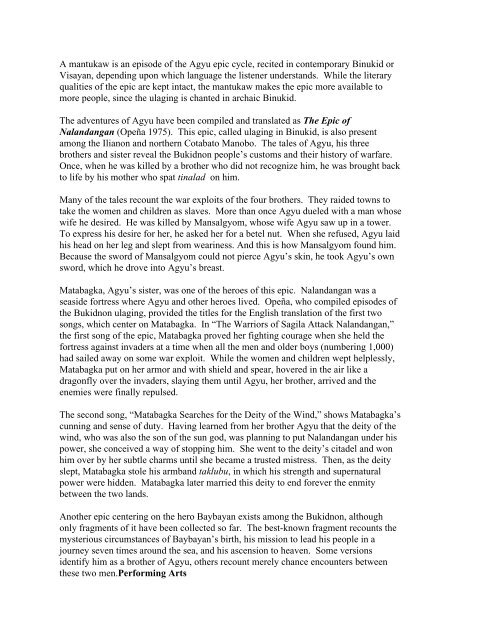You also want an ePaper? Increase the reach of your titles
YUMPU automatically turns print PDFs into web optimized ePapers that Google loves.
A mantukaw is an episode of the Agyu epic cycle, recited in contemporary Binukid or<br />
Visayan, depending upon which language the listener understands. While the literary<br />
qualities of the epic are kept intact, the mantukaw makes the epic more available to<br />
more people, since the ulaging is chanted in archaic Binukid.<br />
The adventures of Agyu have been compiled and translated as The Epic of<br />
Nalandangan (Opeña 1975). This epic, called ulaging in Binukid, is also present<br />
among the Ilianon and northern Cotabato Manobo. The tales of Agyu, his three<br />
brothers and sister reveal the <strong>Bukidnon</strong> people’s customs and their history of warfare.<br />
Once, when he was killed by a brother who did not recognize him, he was brought back<br />
to life by his mother who spat tinalad on him.<br />
Many of the tales recount the war exploits of the four brothers. They raided towns to<br />
take the women and children as slaves. More than once Agyu dueled with a man whose<br />
wife he desired. He was killed by Mansalgyom, whose wife Agyu saw up in a tower.<br />
To express his desire for her, he asked her for a betel nut. When she refused, Agyu laid<br />
his head on her leg and slept from weariness. And this is how Mansalgyom found him.<br />
Because the sword of Mansalgyom could not pierce Agyu’s skin, he took Agyu’s own<br />
sword, which he drove into Agyu’s breast.<br />
Matabagka, Agyu’s sister, was one of the heroes of this epic. Nalandangan was a<br />
seaside fortress where Agyu and other heroes lived. Opeña, who compiled episodes of<br />
the <strong>Bukidnon</strong> ulaging, provided the titles for the English translation of the first two<br />
songs, which center on Matabagka. In “The Warriors of Sagila Attack Nalandangan,”<br />
the first song of the epic, Matabagka proved her fighting courage when she held the<br />
fortress against invaders at a time when all the men and older boys (numbering 1,000)<br />
had sailed away on some war exploit. While the women and children wept helplessly,<br />
Matabagka put on her armor and with shield and spear, hovered in the air like a<br />
dragonfly over the invaders, slaying them until Agyu, her brother, arrived and the<br />
enemies were finally repulsed.<br />
The second song, “Matabagka Searches for the Deity of the Wind,” shows Matabagka’s<br />
cunning and sense of duty. Having learned from her brother Agyu that the deity of the<br />
wind, who was also the son of the sun god, was planning to put Nalandangan under his<br />
power, she conceived a way of stopping him. She went to the deity’s citadel and won<br />
him over by her subtle charms until she became a trusted mistress. Then, as the deity<br />
slept, Matabagka stole his armband taklubu, in which his strength and supernatural<br />
power were hidden. Matabagka later married this deity to end forever the enmity<br />
between the two lands.<br />
Another epic centering on the hero Baybayan exists among the <strong>Bukidnon</strong>, although<br />
only fragments of it have been collected so far. The best-known fragment recounts the<br />
mysterious circumstances of Baybayan’s birth, his mission to lead his people in a<br />
journey seven times around the sea, and his ascension to heaven. Some versions<br />
identify him as a brother of Agyu, others recount merely chance encounters between<br />
these two men.Performing Arts
















